Tips for Introducing a Kitten to Other Pets
Posted: 11/06/2023 | BY: Erin Cain | Categories: Uncategorized
Are you thinking of bringing a new kitten into your home? Are you worried about how the other pets in your house will react to it? Introducing a new kitten to an established household is not always easy. You want to make sure that everyone in the house gets along and that the kitten is comfortable and confident in their surroundings. Here are some tips for introducing your new cat to other pets in your home.
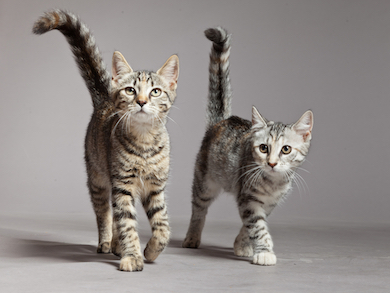
Kitten to Cat Introductions
Introducing a kitten into your household can be exciting but sometimes challenging. All introductions are different and will ultimately depend on the personalities of both cats involved and any other animals present in their environments. To make it less stressful for everyone, and especially your kitten and resident older cat, here are some tips that work best during the acclimatization period.
Create a safe space for the kitten
Bringing a kitty into your home can be rewarding. Still, it’s essential to go about acclimating them to their new home correctly. Make sure you have a separate room for the kitten, such as a large bathroom or one medium sized room, prepared with plenty of food and water as well as a litter box.
This safe space lets your kitten become accustomed to her residence without any intimidation or threat from another adult cat in the household. A separate cat’s room is also helpful if you have an especially shy cat or one or more cats who are not ready for the new kitten’s presence.
Once everything is set up in the safe space, introduce the new cat to your other cat slowly by feeding both on opposite sides of the door. They will learn to associate each other’s presence with the enjoyable act of eating.
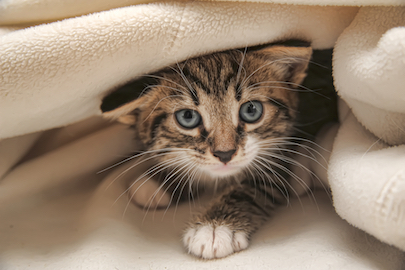
Focus on slow introductions
Introducing cats to each other gradually is the best course of action for a smooth introduction. You should expect an occasional protest from time to time, but these behaviors shouldn’t escalate into fear or aggression between either cat. If things get out of control, separate the kitten and cat until everything has settled down again. Then, start at step one by introducing small measures over several days and weeks before moving on to larger ones if needed.
Many different types of pets can live together, but sometimes they may misunderstand each other. For example, one cat might send “play” signals to another, which could be interpreted as aggression leading to a confrontation. In rare circumstances, cats cannot work out their home territory with another animal. If this case applies to your kitten and older cat, seek professional help from an animal behaviorist or veterinarian for solutions.
Rely on the power of smell
Introduction by scent is one of the most effective ways for pets to get accustomed to a new addition to the four-legged family. It’s important to let your new cat get used to the smells of their surroundings before introducing them into an already established home. Bring the kitten in a carrier. After they are safely situated somewhere away from other animals, allow some time for exploration to familiarize themselves with the other pets’ scents.
Keep your new cat and old pet happy by placing their food bowls on opposite sides of one door so they can get used to each other’s scents. Start with feeding them at least 3 feet apart, then move the bowls closer to each closer over time. Additionally, experiment with the cats’ scented items to get your cats used to each other. Give them an object, such as a blanket or bed, that smells like them and place it in an area where they feel comfortable. Each cat party will learn to identify and become comfortable with each other’s smell, making complete introductions a more straightforward process.
Change up living spaces
If you want your new cat to feel comfortable in her surroundings, allow them some free time while the other house pets are confined in a different part of the home. This way, the little kitty can get used to the scent of everything around without having any face-to-face meetings with other cats and being scared by them.
Cats can become very close companions once they have been introduced. Introducing your cats to one another should happen only after ensuring that both cats are comfortable with each other. Remember to provide enough for each cat to go to if they become overwhelmed and need a time out. Until the cats are okay with each other, you may want to keep an area designated just for meetups, separated by a baby gate. Hence, all interactions take place within these parameters.
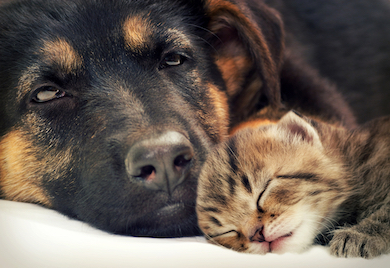
Kitten to Dog Introductions
While cats and dogs can get along famously, it is important to remember that some dogs have a high prey drive. These canines should never be left alone with cats, especially kittens. Felines can become frightened and defensive if they feel threatened by a dog. It doesn’t take much for an enthusiastic pup to hurt or even kill a kitten, even during play. It’s best for these types of canine companions if you start slowly by acclimating your new cat to their world using the following tips.
Practice canine obedience
Does your dog need an obedience refresher? They do when a new pet is coming into their home territory. Firmly establish or re-establish the four critical canine commands: “sit,” “down,” “come,” and “stay.” Use small pieces of food to increase your dog’s motivation when performing these tasks. Dogs need not only attention but also rewards for doing what we want them to do, and high-quality treats or tidbits will help your dog focus more on you rather than the new cat.
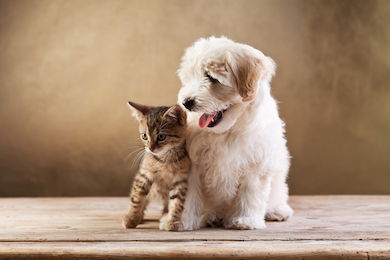
Control initial face-to-face meetings
Like the new cat and resident cat introductions, feed your cat and dog on the opposite sides of a door. Move their food bowls closer to the door each day until they eat comfortably near each other.
When that step is accomplished, and the cat and dog are ready, let them meet in a controlled environment. The cat and dog should be on opposite sides of an area or room. Put your dog on a leash, give them the appropriate “sit” or “lie down” commands, and have treats ready to reward them for good behavior. Have a family member or friend sit quietly beside your cat without restraining them, and make sure they have tasty treats on hand to feed the new cat. In this way, both the kitten and the dog will associate each other’s scents with positivity and yummy treats.
Keep these introductory visits short so that your pets can become used to one another’s presence easier. Always watch the pets’ body language when they are in the same space. If there is aggression from either pet or both parties involved, separate them. Repeat these steps until both pets tolerate each other without evidence of fear or aggression.
Introducing a kitten to your dog can be challenging, but it’s worth the effort. Your pets might not become friends right away, and you may need patience for this process; however, they will hopefully become furry friends with time and effort.
Let your cat explore
Next, give your new cat the freedom to explore the room and the dog at their own pace while he is still on leash and in a “down-stay.” Meanwhile, give both of them treats for exhibiting calm behavior. If your dog gets up from the “stay” position, use treats to reposition them back into a “stay.” Praise them for following commands.
If your cat becomes fearful, aggressive, or runs out of the room, you’re not ready to progress. Take a break and work on introducing the pets slowly again in stages.
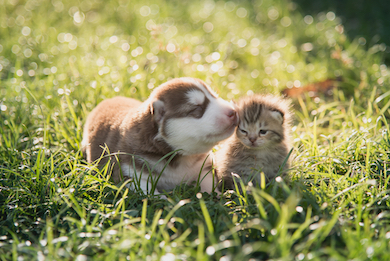
Supervise all kitten-dog interactions
You should supervise each face-to-face meeting between your dog and cat to ensure both pets are safe. Make sure that you keep them apart when you’re not at home. The kitten should have an escape route and ample hiding places around the house if they are scared during the introduction process. Kittens are much more vulnerable to danger than adult cats. Your dog and kitten should stay separate until your kitten has grown big enough to hold their own.
Always use positive reinforcement and patience
You must teach your dog that chasing or being rough with your cat is unacceptable behavior. Still, they also need to learn how to behave appropriately and get rewarded for doing so. This process will take time if you have an energetic dog or a dog with such a high prey drive. You don’t want the cat to develop fearful and aggressive problems, so the resident dog must learn more self-control and avoid undesirable behavior.
Suppose you always punish your pup when the feline crosses his path. In that case, it’s likely going redirect aggression towards the new cat. Make every interaction as positive as possible and tie it into a treat lure, so your dog learns to associate good behavior around the cat as a way to earn tasty treats.
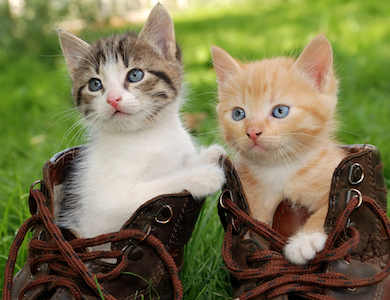
Make sure all your pets are healthy with a pet insurance plan.
Pet introductions can always be a little hairy, and although most new meetings end well, sometimes accidents can occur. A pet insurance plan for your pets is the best way to ensure that your pets are covered and protected, no matter what happens. Even better — purchasing plans for more than one pet gets you a multi-pet discount on insurance. Let Pet Insurance Review round up the best pet health insurance plans for your pets and your budget. Get started with a free quote for your dog and cat today!
References:
1. Tufts and Paw. (2020). The Definitive Guide to Cat Behavior and Body Language. Retrieved from https://www.tuftandpaw.com/blogs/cat-guides/the-definitive-guide-to-cat-behavior-and-body-language
2. Fetch. (2021). Dog Training: Obedience Training for Dogs. Retrieved from https://pets.webmd.com/dogs/guide/dog-training-obedience-training-for-dogs#1
3. Bergeland, H. (2021). What Does it Mean When a Dog Has a Strong Prey Drive? Retrieved from https://www.dailypaws.com/dogs-puppies/dog-behavior/dog-psychology/what-does-it-mean-when-a-dog-has-strong-prey-drive
Disclaimer
The information contained on this blog is intended for informational and educational purposes only and should not be construed as medical advice. It is not a substitute for professional veterinary care. Always consult with your veterinarian before making any changes to your pet's health care or treatment plan.
The authors of this blog are not veterinarians and do not claim to be experts in pet health. The information provided here is based on our own experiences and research, as well as information from reputable sources. However, we cannot guarantee the accuracy or completeness of this information.
We encourage you to do your own research and consult with your veterinarian before making any decisions about your pet's health.
Compare top pet insurance providers plans.
Enter your dog’s age in years and months to calculate their age equivalent to human years.
Calculate your dog’s ageEnter your cat’s age in years and months to calculate their age equivalent to human years.
Calculate your cat’s age